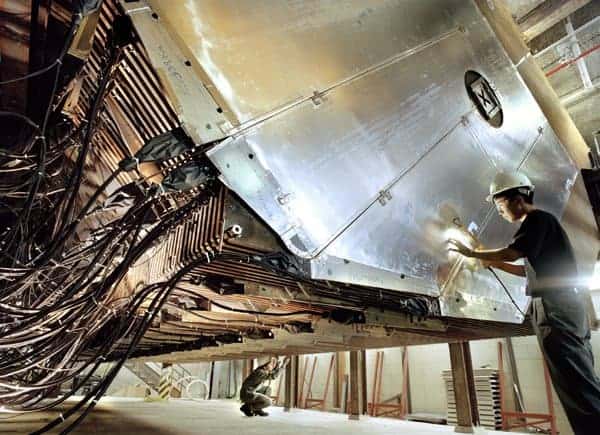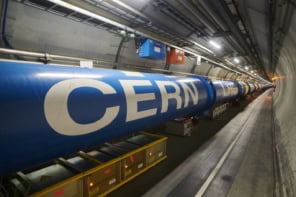
Scientists interested in the upper atmosphere should turn their attention to measurements made deep underground — says an international team of physicists who have noticed that the number of cosmic-ray remnants hitting Earth is linked to freak warming events in the upper atmosphere. The link implies that measurements of cosmic rays — both future and past — could help scientists improve climate and weather forecast models.
Cosmic rays are mostly high-energy protons and are constantly bombarding atoms in Earth’s atmosphere to create pions. These pions either decay into lighter muons or continue to interact with nearby atoms and avoid decaying into muons. If the atmosphere is cool and thick then the chance of continued interactions is much higher, and the number of muons generated is therefore far fewer than when the atmosphere is warmer.
As a result, underground experiments that detect these characteristic muon flashes tend to see more events in summer than in winter. But now a team of researchers has found that muons can also reveal big changes in atmospheric temperature on very short timescales.
Lurking in the background
The collaboration — which is led by Scott Osprey and others at the National Centre for Atmospheric Science (NCAS) in the UK — began considering this possibility while studying the background particles reaching the underground AMANDA neutrino experiment at the South Pole. In data recorded in 2002, when the upper atmosphere in the southern hemisphere was warmer than usual, they noticed a rise in the number of muons.
“They [the AMANDA team] didn’t know this was in their data until we showed them,” says Giles Barr, an Oxford University particle physicist who is part of the NCAS collaboration.
To confirm that the effect was real, the collaboration turned to their own muon data, taken in the northern hemisphere from the MINOS neutrino experiment at a disused iron mine in Minnesota, US. “It’s much easier to know what systematic detector effects need checking in your own data,” adds Barr. Again, they saw the correlation.
The most surprising feature of the correlations was the fact that they could even flag spikes in high-altitude temperature, sometimes as much as 40 degrees, taking place over just a few days. These events, known as sudden stratospheric warming, are thought to occur owing to the passage of huge atmospheric “Rossby” waves which shift heat from the tropics to the poles. In the past meteorologists had only satellites and weather balloons to study sudden stratospheric warming — now, claims the NCAS collaboration, they could use cosmic ray measurements too.
“They are important to study not only because they represent the most striking display of variability in the stratosphere, but also because of their links with weather occurring [lower down] in the troposphere, where our weather takes place,” explains Osprey, also at Oxford University.
More data needed
Serious measurements of cosmic rays go back more than 50 years, way before satellites began examining the atmosphere. This means that the cosmic-ray measurements could be used to corroborate past balloon data and perhaps give meteorologists a better handle on how the climate has evolved. Also, says Osprey, it is possible that cosmic rays will turn out to have niche applications in weather monitoring.
“Historical records of muon rate might be interesting — certainly the stratosphere was poorly observed prior to the 1960s,” says Peter Haynes, an atmospheric scientist at the University of Cambridge who is not involved with the research. “The muon rate seems to provide an absolute measurement of temperature — that is, there is no bias problem.”
However, Haynes points out that the muons reflect atmospheric temperature at a single location, which may make it difficult to see how the climate is changing as a whole. There are only a handful of other muon detectors in the world, and it would hard to justify building more for weather purposes alone.
Nevertheless, Barr thinks that it is a exciting discovery: “Lots of things affect cosmic rays on their journey through the galaxy, into the solar system and then into the atmosphere. Historically, cosmic rays have been notoriously hard to work with, so to understand how to use them to measure something is very satisfying.”
The research will be reported in an upcoming issue of the journal Geophysical Research Letters.



